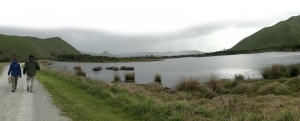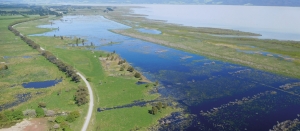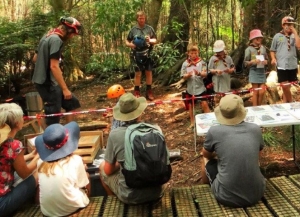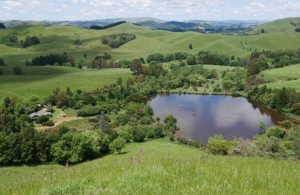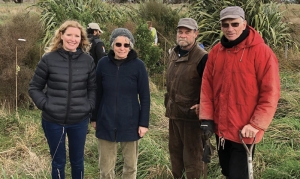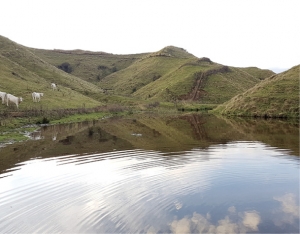Displaying items by tag: Wetlands
DU's trip to a 'magic place'
The wetland at Nick's Head Station at Muriwai, south of Gisborne, is a world-leading example of positive human interactions with the land, and of what vision and money can achieve.
General manager Kim Dodgshun has worked at Nick's Head Station since 1994, eight years before the current owners bought the property. "They inherited me and we've worked well as a team ever since," Kim says.
When Kim arrived, the land that is now the main wetland was being grazed with livestock roaming all over, and with cows wandering along the beach. "It was nothing like it is today."
Early on, Kim had the idea of creating a bird reserve on the property and ran it past wildlife ecologist and former Wildlife Service ranger Sandy Bull.
The plan, however, hit a snag when the owners at the time said they did not wish to proceed with something that would not produce financial returns.
Undeterred, in 1995 Kim managed to obtain a $15,000 Natural Heritage Fund grant from the local district council and, with Sandy's help, starting trapping. "We caught a big polecat down on the beach," Kim says.
They also put up "No shooting" signs – it had been a popular duck shooting site, fenced off 15 hectares and planted flax around the outside. The birds flocked in, bringing seeds from other wetlands in the area and the plants began to grow.
The story of the wetland took another turn in 2003 when the farm changed hands after the Overseas Investment Commission approved an application from a US billionaire to buy the land, in what turned out to be a 12-month-long process.
He had first visited the farm in 2002 and embraced Kim's plans to create a wildlife reserve.
The final step for the sale was to gain iwi approval. Kim says communication was the key and once the iwi knew what the owner planned to do with the property, the deal was approved.
In response to Kim's plans, the owner said, "Let's make this bigger and better", and brought out renowned landscape architect Thomas Woltz from the US to design the wetland, with advice from Kim and Sandy.
A previous manager who had farmed there for 35 years had set in place the foundations to drain the saltwater from the low lying areas. He put up a netting fence on the beach which collected all the driftwood and storm debris, building a natural wall with sand.
Next, he added another fence on top of that and planted it out with marran grass and other plants.
Later, in the 1960s, a drain was put in to get rid of the remaining saltwater but a narrow, shallow channel remained, with 700 acres of catchment running into it. In summer it dried up. The surrounding paddocks were all very wet with no drainage.
Kim had already planted some native blocks but as Thomas Woltz learnt more about New Zealand and its trees, "the master plan was to revert the land back to how it was 700 or 800 years ago, with a profitable farming operation, back when there were no predators and the land was covered in native trees", Kim says.
Planting began in earnest in 2003 and now there's almost 700,000 natives on the property – coastal varieties with "the big fellas" – rimu, matai and totara – planted among them.
The wetland project began in 2005 – plans were drawn up, the land was surveyed and work began, initially with six diggers.
Kim had warned the contractors that trucks with wheels and 20-tonne diggers wouldn't work in the boggy terrain, but they brought them in anyway and all of them got stuck.
Which left the six smaller diggers. Firstly, a wall was put in to stop the saltwater coming in over the original wall at the beach. "We put in some more small ponds up the valley and worked our way west."
Deep channels – "about 2½-cars deep" – were dug out to ensure the wetland had water year-round.
The material excavated from the channels was made up of a layer of Plasticine-like blue tacky soil sandwiched between shells and "rubbishy" soil. The blue material was used to seal the walls or build the islands, while the "rubbishy" soil helped shape them.
Diggers scraped up the topsoil which was carted on to the shaped islands by trucks with tracks to prepare them for planting.
However, when they came to seal the western side of the wetland, they ran out of the blue soil so plastic liner had to be used in some sections.
"We pegged out all the walls and had three diggers in a row, one digging the holes, another with a big roll of the plastic, working at snail pace, unrolling it, with a third quickly filling it in before the walls collapsed," Kim says. Thankfully, it worked.
"Once it was all done, we had to pump all the water out. "We got council permission to pump it out into the sea over sheets of corrugated iron to protect the beach."
In the process, they found some old kahikatea, big, old stumps of trees, leading them to believe that, pre-settlement, it must have been an old kahikatea swamp.
"There are some stumps on the beach visible at low tide that have been dated at more than 8000 years old," Kim says.
As well as dealing with the challenges presented by the terrain, during planting, they encountered another problem.
Holes were dug with an augur, and some crystal rain put in with soil over the top before the tree was planted with a fertiliser capsule.
Later they went back to one of the islands to put in stakes to mark where the native plants were but found that most of them had been pulled out.
"All the rats were just pulling them out and eating the fertiliser caps. They were having a ball."
The answer was to use about 100 bait stations with Pestoff rat bait, from Farmlands, and "there were bucketloads of rats coming in," Kim says. It's slowed down now.
"That was just another little challenge. I can't believe how well the plants have grown."
Now the islands are all finished and planted with native trees – 10,000 trees to the hectare. On the hills, it's 2500 to the hectare.
The wetland has two 1ha islands and several smaller ones. All the islands are in place of valleys, which was Thomas Woltz's plan, imagining erosion coming down and islands forming.
At its peak, 25 people were working on the project. The labour was all local and all the trees were sourced from the Muriwai area. "Now the locals come to get our native trees," Kim says.
The farm is 3300 acres in total with nine kilometres of coastline. It runs Angus cattle, 285 breeding cows and 3300 sheep. This is likely to be reduced to 3200, with the aim of getting more out of fewer stock, by doing things better, "by selling them when they are ready to go and when the market is ready to take them".
"We are looking at the possibility of going down the regenerative farming path, though the steep contours of Nick's Head Station add to the challenge – more investigations in this area are required."
Facial eczema is a problem so the farm focuses on sourcing facial eczema-resistant stock. The farm uses dicalcic phosphate fertiliser, not straight superphosphate, and nitrogen, which was seldom used, has not been used for about eight years.
The station employs a staff of 16, who look after conservation, including a former DOC worker who does trapping and twice-weekly night shoots by bike, general hands, stockmen, groundsmen, a secretary, a citrus manager and assistant, who have 50 hectares of citrus to tend, plus contractors.
Kim pauses, distracted by something that needs fixing. "Everything we do on this place, we got to maintain it.
"We've got this magic place that we've all had something to do with and created what it is today. We can't let it go back. We can't let wild pine trees start growing.
"We've got convolvulus – we've got to keep taking it out – we've got kikuyu grass on the farm that we have been spraying, we have got to keep at it. "
"The old place never sleeps."
- The bus trip to Nick's Head Station was organised by Kees and Kay Weytmans, who provided delicious, nutritious packed lunches. Kees' efforts to make sure everyone was comfortable during the talks on the jetty by providing lucerne bales to sit on were also much appreciated.
- For more on Nick's Head Station, watch Thomas Woltz's Ted Talk at www.youtube.com/
watch?v=9VlY-3V63yI.
Explore the Wairarapa Moana
Nationally Recognised restoration efforts
According to WaiWetlands, you should prepare to be inspired by nationally recognised restoration efforts at Wairio by community group Ducks Unlimited.
Once a paradise for waterfowl and aquatic species, the wetlands were greatly affected by drainage schemes in the twentieth century. Today they are a living example of what is possible through wetland restoration efforts.
Go to the Wairarapa Moana Wetlands website and read the whole story
World Wetlands Day events
The 2020 Puweto Festival honoured the day at Lake Rotopiko, which DU visited during its 2018 conference in Hamilton. Wetland bird masks, a critter colour-in, mudfish scrabble, eels and ladders, live geckos, kahikatea tree climbing and a virtual reality lake dive were among the offerings for families who attended.
The event was named after the shy puweto/spotless crake that lives around the margins of the lake.
Rotopiko is being developed into a National Wetland Centre, with newly completed boardwalks, information panels and an interactive discovery trail. During the festival, Treelands (local arborists) climbed up kahikatea to install bat roost boxes – something they have been doing all over the region. Other activities around the country included a guided walk at Harbourview-Orangihina Park in Te Atatu on 1 February and Matuku Reserve Trust in West Auckland had an open day to show off its wetland restoration and give the public a chance to see pateke.
In Wellington, Zealandia visitors were able to talk to experts from organisations including the Hakuturi Roopu, Greater Wellington Regional Council and Lakes380 to learn more about freshwater and wetlands in New Zealand.
In Marlborough, visitors were invited to check out a community-led wetland restoration project and walk around the Grovetown Lagoon. A guided walk was held around the Travis wetland in Christchurch.
The QEII National Trust took the opportunity on World Wetlands Day to introduce a new QEII wetland covenant to protect the Galloway Wetlands in Ashburton.
The trust said: “Craig and Lyn Galloway bought their farm in 1986 on the south bank of the North Branch of the Ashburton River. When they purchased the property, all paddocks had been developed except for the wetland paddock which remained uncultivated.
“Craig and Lyn applied to the Ashburton Water Zone committee for a grant to expand their successful riparian planting programme to the margin of a stream and man-made pond.
“Spring-fed channel wetlands like theirs have virtually disappeared elsewhere on the Canterbury Plains. They decided to place a covenant over the whole
6-hectare wetland complex to preserve the relict pre-human vegetation.
“The covenant is a rare example of the highly diverse wetland complex and landform created by hydrologically connected springs associated with braided rivers. The wetland ecotone contains a spring-fed mossy fen, bog rush channel wetland, stream, manmade ponds, pukio and kiokio fern swamp, and toetoe marsh.
“The Galloway Wetlands protect the only known manuka, sphagnum moss and the pink-flowered wetland ladies tresses orchid (Spiranthes novae-zelandiae) on the Ashburton Plains.” Matagouri and the rhizomatous shrubby violet known as a porcupine shrub have survived on the stony ridges in the covenant but both are rarely encountered elsewhere in the region, the QEII Trust said.
The landowners plan to supplement these species with new plants, grown from seed sourced from the local area. This covenant is one of very few
that meet all four national priorities for protecting rare and threatened biodiversity on private land.
But it was not all good news for wetlands. In a statement released to mark World Wetlands Day, Forest and Bird said West Coast landowners had wiped out more wetlands in the past 20 years than landowners in any other region. Aerial images from around the country supplied by Landcare Research showed that wetlands on private land were still disappearing at an alarming rate.
The West Coast was the largest wetland region in New Zealand, with nearly 84,000 hectares of freshwater wetlands, 14 per cent of them in private ownership, Forest and Bird said.
Handy guide defines what makes a wetland
The first step in protecting wetlands is being able to identify them. To help landowners identify wetlands on their property, Greater Wellington has developed a guide: Spotting a wetland on your land.
This guide is a set of durable flip cards designed to be used outside, containing photos of different wetland types and plant species likely to be found in and around wetlands. Greater Wellington is also helping landowners to protect and manage waterways through its Healthy Waterways programme. This support can include help with the cost of fencing, pest control and planting.
If you have any questions about wetland identification or are planning to do anything in or around waterways or wetlands, get in touch for free specialist advice at This email address is being protected from spambots. You need JavaScript enabled to view it. or This email address is being protected from spambots. You need JavaScript enabled to view it..
For more information visit www.gw.govt.nz/healthy-waterways.
Welcome to my world
Pockets of the 508-hectare farm resemble an arboretum, with precious specimen trees fenced and surrounded by other trees planted there to protect it from stock and the elements.
Years ago Jim attended a Landcare lecture about having a good influence on the land.
Today the giant eucalypts, the valuable Tasmanian blackwoods (Acacia melanoxylon) (a good straight trunk can be worth $4,000 a cubic metre, says Jim), Douglas firs and Oregon pines, totara, sturdy pin oaks, giant redwoods, some kahikatea that Forest & Bird gave him, towering Leyland cypresses planted to screen the farm from SH2, tupelos and liquidambars with their brilliant autumn colour and hundreds of others are all testament to how he carefully he took that lecture to heart.
He is watching the progress of a hybrid oak he got from Appletons Tree Nursery in Nelson, a Quercus robur ‘Fastigiata’, which has an elegant upright shape and appears to be thriving.
The kanuka and manuka, which are almost in full flower (“it’s nearly time to tell the beekeeper in bring more hives”), have gained more value – “from cutting it and bulldozing it, I am now planting it... for the bees”.
On his daily rounds of the farm that his son, Simon, now runs, Jim gets a lot of pleasure seeing the trees stake their claim on the land, both the trees that preceded him and the ones he has planted. The biggest rata on the property was there long before he took over the farm.
“I thought the stock were going to kill it because they used to camp under it so that’s why we fenced it off and planted around it; that tree is now worth about $5,000 to me”, but it’s not a cost that Jim begrudges.
It’s clear to see Jim, who is now in his mid-70s, loves his trees.
When he ran the farm, which has been in his family for more than 150 years, it was about 60:40 cattle to sheep, with 200 station cows. Now his son runs 40 station cows but he’s also rearing bulls, which is cheaper than buying them in.
They are mostly speckle park crosses and angus hereford crosses.
Jim enjoys still being part of the farm and helps out with the haymaking – mowing paddocks – and checking on stock and other tasks. “I need to get
out – this morning I’ve done a couple of hours of spraying,” he said.
In line with current regulations, and with more stringent rules around the fencing of waterways likely, Jim says his son is lucky because a lot of it, along with planting, has already been done. “We were ahead of our time. We did it mainly to control the river wood trees, which were taking fences out.”
Simon is now trialling different tree varieties to carry on the planting but it is still going to be a massive cost to ensure all the waterways are compliant. The planting has other benefits as well as keeping stock out. Jim has discovered that a one-kilometre section of one of the streams that has established trees along it is about 2 degrees Celsius cooler because of the shade.
The Te Mara stream goes into Waipoua River on the property but by the time the Waipoua has reached Masterton, it has accumulated a lot of water, from the Kiriwhakapapa, Mikimiki and Matahiwi streams as well.
About 20 acres (8ha) of the property between the woolshed near the homestead, where Simon now lives, to where Jim lives above the “Big Pond” is covered by a QEII covenant. Jim thinks now that the covenant should be extended to another area on the farm called Norm’s Marsh.
It was built in tribute to Norman Marsh, a great supporter of DU and generous benefactor when it came to paying for the cost of creating wetlands, several – on Jim’s and other properties – thanks to Norm’s largesse. Jim, who was made a Member of the New Zealand Order of Merit for his services to conservation in 2016, is a life member of the QEII National Trust.
The property has about 32 ponds in all. One was created after former DU president John Cheyne, on a visit to the farm, suggested a particular rushy patch would make a good wetland. “It took me three days to bulldoze it and I had to hire a digger for a half-day,” Jim says. Another he calls the “10-Minute
Wetland” – “that’s how long it took to block the end of it with a bulldozer – a pair of shoveler nested there this year and had five ducklings”.
On the big pond, Jim’s two mute swans, which he suspects are both male,compete with scores of scaup for the daily treats delivered by Jim. He says there were 32 scaup ducklings on the pond last year. As well as feeding the swans and scaup and other ducks, Jim has more for the pheasants, Cape Barren geese and quail that frequent the lawns around the house.
The other birds that visit the farm also have plenty to feast on. There’s dragon’s gold kowhai and kaikamako for the tui and bellbirds, tree lucerne,
or tagaste, for the wood pigeons and Himalayan strawberry trees, which all the birds love. He notes that the lucerne makes excellent firewood, “as good as maire”, something that many people don’t realise.
A welcome distraction over Christmas and New Year, as Jim recovers from an injury, has been the arrival on the lawn of some baby quail looking “like little bumblebees”.
He has been trying to breed quail for several years – there were five last year – but this year he has spotted one pair with 11 chicks, one with three and another with two chicks. “I can just look out the window and see them feeding on the lawn. It’s just magic to have them around all the time.”
For Jim, one of his favourite times of day is at night – sitting out on the deck having a whisky, with the Cape Barren on the lawn and the pheasants coming up to use the automatic feeder, and quail running along the deck.
Bittern steals the show
Ducks Unlimited recently received a substantial donation to put towards its restoration work at Wairio Wetland.
Janet and Patrick Velvin, who live in South Wairarapa, are passionate about conservation, particularly water conservation, and contacted The Gift Trust, a philanthropic advisory service, to identify suitable causes they could support.
Cheryl Spain, executive director of The Gift Trust, said they had been impressed with the research on Wairio and DU’s partnerships with the Department of Conservation, Greater Wellington Regional Council and Victoria University, particularly its links with the student research projects at Wairio, and had chosen Wairio as a suitable recipient.
The Velvins visited the wetland for the first time and took part in a planting day with Victoria Uni students in early July.
After helping with the planting, they were given a guided side-by-side tour by Ross Cottle, who identified a suitable site on a promontory for a viewing hide, which could be constructed with some of the funds donated by the Velvins.
During the tour, Patrick asked if there were bitterns in the wetland, and as if on cue, a bittern obliged and flew in front of the them.
Janet became aware of the work at Wairio Wetland through the book Wairarapa Moana: The Lake and its People.
Janet said after the tour they were impressed with Ducks Unlimited and happy to give a donation towards the work at Wairio.
The evolution of Courtney’s Close
On a parcel of land at Mangaone in Raetihi, in an area that was once an unproductive, narrow, boggy drain bound by strong ridges, co-owners Graeme Berry and Paddy Chambers saw a potential habitat for waterfowl.
DU Patron Di Pritt says, “Since Graeme and Paddy Chambers have been involved at Mangaone, from 2004, they have created six major wetland areas – ranging from an acre to 10 acres – which are all fenced and they have planted about 38 acres. Another four major ponds have also been created.
“It is an amazing achievement, and was fully supported by the previous owner, Jon Preston.”
Their latest project is Courtney’s Close, a wetland area they named after the Horizons employee who helped with the project.
They created it by splitting a 300-acre paddock in half and building a 650-metre deer fence. The wetland area now consists of four ponds outside the fence, and three, with room for two more, enclosed by the fence.
This means animals have access to water but are excluded from the lower wetlands and impurities are filtered out along the way.
Inside the fences Graeme and his partner, Bang, have planted natives, protected from the deer.
Pekapeka wetland earns Pride of Place award
One of the areas to be visited during the AGM weekend.
Hawke’s Bay Regional Council was delighted to receive a Distinction Award from the New Zealand Institute of Landscape Architects at the NZILA Resene Pride of Place Landscape Architecture Awards for 2013 in April.
The citation for the award states that Pekapeka Wetland provides a range of experience opportunities for users and acknowledges the contributing work of Shannon Bray Landscape Architect.
Stephen Cave, HBRC’s Operation Environmental Manager said “This is one of three awards for Pekapeka Wetland since 2009, realising its champion value and raising the awareness of wetlands throughout Hawke’s Bay.
“The award from NZILA is a great reflection on the restoration work happening in Hawke’s Bay and we are very honoured. It is estimated this award puts Pekapeka Wetland in the top five percent of landscape architecture projects undertaken throughout New Zealand in recent years.”
The award recognises Pekapeka Wetland as a high quality interpretive site for wetland restoration. It is noted for integrating public accessibility with educational features, using local materials and stories.
Stephen is quick to acknowledge a number of the project’s key supporters, particularly Shannon Bray, Waa Harris, Peter Dunkerley, the Community Foundation, Rotary Club of Stortford Lodge, Eastern and Central Community Trust and the preliminary work of Titchener Monzingo Aitken Ltd.
Iwi groups plus many children from schools (particularly Pukehou School) and Kiwi Conservation Club all played a key role in planting areas around the swamp.
Help at hand for Waikato wetlands
Tony Roxburgh, chair and trustee of the National Wetland Trust provided the AGM with a glimpse of happenings with wetlands in Waikato.
The Trust plans a state-of-the-art interpretation centre, with research and educational facilities, wetland gardens and heritage trails on land next to Lake Serpentine in the Waipa district. This is one of 69 peat lakes in Waikato.
Issues to be worked through include highway access and formal agreement with the Department of Conservation. DoC has already given approval to construct a 1.4 km predator fence around 10ha of the reserve at Lake Serpentine near Ohaupo.
Tony said the plan includes a visitor concept plan, an interpretation plan, business plan and landscape developed for the site. These were funded by grants from Transpower, Trust Waikato and Waikato Regional Council (Environmental Initiatives Fund), and supported by Waipa District Council.
They are looking at the best way to restore wildlife, including the feasibility of a predator exclusion fence. Funding from the Waikato Catchment Ecological Enhancement Trust, and a grant from the DoC’s Community Conservation Fund allowed them to produce a re-vegetation plan to restore vegetation and habitat.
Students of Te Awamutu School have been searching for native and exotic fauna, and have been the first to confirm long-tailed bats at the site. Other species confirmed include Australasian bittern, North Island fernbird, Black mudfish and Spotless crake.
The pest fence was completed in June this year and they now need sponsors and donations to help with pest eradication and re-introduction of native species.
Other work in the Waipa district includes Lake Ngaroto one of the peat lakes. It currently floods the peat and Tony said this could be one of the larger projects for the Waikato basin aimed at reducing loss of wetland and preserving the quality of the peat lakes.
Canada needs wetlands (so does NZ)
Ducks Unlimited Canada are celebrating 75 years of existence this month, October 20013. In a special souvenir issue put out by the Calgary Herald there is a piece that explains why Canada needs wetlands. In New Zealand we need wetlands to be looked after as well, so here are the reasons given by the Canadians. These are reasons New Zealand can also take to heart.
Ducks Unlimited Canada are celebrating 75 years of existence this month, October 20013. In a special souvenir issue put out by the Calgary Herald there is a piece that explains why Canada needs wetlands. In New Zealand we need wetlands to be looked after as well, so here are the reasons given by the Canadians. These are reasons New Zealand can also take to heart.
Wetland - like marshes and ponds are some of the most productive ecosystems in the world. They work behind the scenes, providing many important benefits to all Canadians.
Clean water: wetlands filter harmful pollutants from the water we drink and improve the health of our lakes and rivers.
Homes for wildlife: hundreds of species depend on wetlands for food and raising their young.
Flood and drought prevention: wetlands act like giant sponges, holding water during wet periods and releasing it during dry periods. Fun and recreation: wetlands are beautiful places for people of all ages to be active and enjoy nature.
Given all they do, it is shocking that wetlands continue to be lost. Every day up to 80 acres of wetlands are lost in Canada. Your help is needed. Join Ducks Unlimited, Canada’s conservation community at www.ducks.ca
The following are excerpts from another article in that Calgary Herald publication linking science with nature and wetlands. This is already happening with the work DUNZ has
instigated at Wairio Wetland in the Wairarapa. In Southland Waituna Lagoon is also
attracting scientific interest.
Science is helping to increase the knowledge about wetlands and what they do. Ducks Unlimited Canada biologist Owen Steele said: “As one of the Earth’s most productive ecosystems, wetlands are also among the most threatened.
“A lot of people don’t care if wetlands are a good place for ducks or frogs or anything else, society is so urbanised we’ve lost touch with nature. “But if their home is going to get washed away of they’re no longer able to drink their tap water because of disappearing wetlands, they are suddenly interested. “
Steele says if the river that runs through their town is going to be green, scummy and unattractive to walk by, they are going to sit up and pay attention.
Research in North America clearly shows the critical environmental benefits wetlands provide, which include clean water and habitat for wildlife, reducing flooding and erosion and lessening the impact of climate change.
As wetlands are lost so too are the benefits they provide. These include phosphorus removal - without wetlands more phosphorus will go into our lakes and rivers.
There is also the carbon stored in wetlands. The biological diversity and the social benefits of wetlands start adding up. Landscape changes that include roading, rail lines and pipelines can all affect wetlands.
Owen Steel said: “Things like our jobs, the economy and our health are all important issues; we need to figure out a way to link wetland protection and conservation to those issues.
“We still have a long way to go in prevention of wetland loss.”

